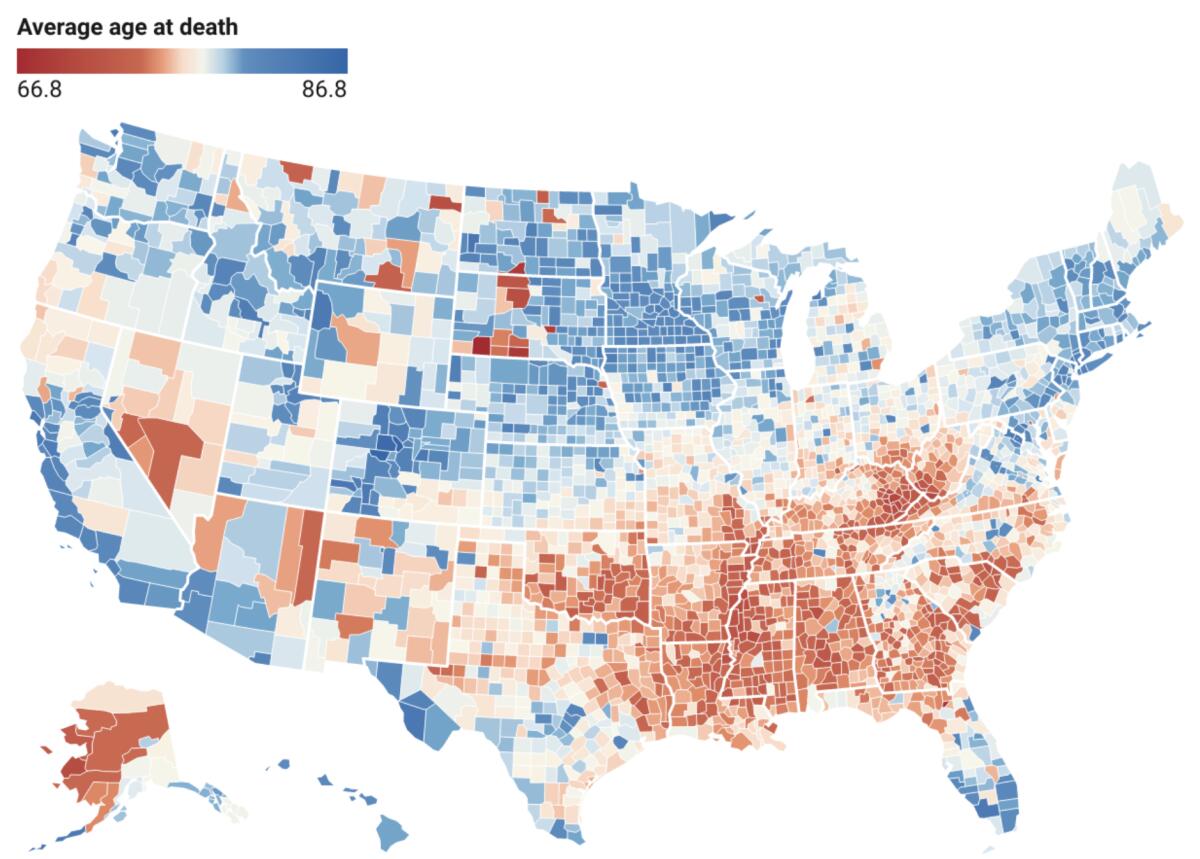America’s decline in life expectancy speaks volumes about our problems

- Share via
Years of widening economic inequality, compounded by the pandemic and political storm and stress, have given Americans the impression that the country is on the wrong track. Now there’s empirical data to show just how far the country has run off the rails: Life expectancies have been falling.
The Centers for Disease Control and Prevention reported last year that life expectancy at birth fell in 2021 to its lowest level since 1996, a decline of nearly a year on average from 2020. That was after a decline by 1.8 years from 2019 to 2020, producing the worst two-year decline since 1921-23.
These figures open a window on a set of pathologies unique to America among developed countries.
America is seeing the greatest gap in life expectancy across regions in the last 40 years.
— Jeremy Ney, American Inequality
COVID-19 is the most obvious and convenient culprit, both for the absolute decline in life expectancy and the divergence between the experiences of the U.S. and its economic peers.
Most developed countries have begun to recover the longevity losses they experienced during the pandemic; thus far, there’s scant evidence that the U.S. is following the trend.
Get the latest from Michael Hiltzik
Commentary on economics and more from a Pulitzer Prize winner.
You may occasionally receive promotional content from the Los Angeles Times.
The U.S. suffered a greater rise in mortality and premature deaths than its peer countries during the pandemic years of 2019-21, according to the Peterson-Kaiser Family Foundation Health System Tracker.
“COVID-19 has erased two decades of life expectancy growth in the U.S., whereas the average life expectancy for comparable countries has decreased only marginally, to 2018 levels,” the Health System Tracker found.
That may not be surprising. Few developed countries other than the U.S. turned COVID and anti-pandemic options into political issues, converting such proven treatments as vaccines into partisan litmus tests.
But COVID is far from the only explanation for America’s dismal trend line. The pandemic accounted for about half the decline in life expectancy, according to the CDC. “Unintentional injuries,” a category that includes drug overdoses, contributed an additional 16%, followed by heart disease (4.1%), chronic liver disease and cirrhosis (3%) and suicide (2.1%).
The Wall Street Journal says America ‘soaks the affluent.’ Try to hold back your tears.
Those factors haven’t occurred in a vacuum. They’re connected to what the CDC called “the social determinants of health” — “economic policies and systems, development agendas, social norms, social policies, racism, climate change and political systems.”
Americans with the shortest life expectancies “tend to have the most poverty, face the most food insecurity, and have less or no access to healthcare,” Robert H. Shmerling of Harvard Medical School wrote in October. “Additionally, groups with lower life expectancy tend to have higher-risk jobs that can’t be performed virtually, live in more crowded settings, and have less access to vaccination, which increases the risk of becoming sick with or dying of COVID-19.”
The magnitude and diversity of the problem should prompt Americans to engage in serious soul-searching. There’s little evidence of that happening.
The most important governing factor is economics, observes Jeremy Ney, an expert in graphically displaying social and economic disparities.
“There’s a really strong relationship between life expectancy and income,” Ney told me. “Income is tied in with a lot of other things, like your ability to afford healthcare, your housing security, your distance from a toxic chemical site, things like that.”
What’s striking about recent figures compiled by Ney are the geographic disparities in longevity.
“America is seeing the greatest gap in life expectancy across regions in the last 40 years,” Ney says.
According to 2020 death records from the Centers for Disease Control and Prevention, the longevity gulf is now 20 years wide — ranging from an average life expectancy from birth of 66.8 years in Oglala Lakota County, S.D., to 86.8 years in Summit County, Colo.

The former is entirely within the Pine Ridge Indian Reservation; the latter is a hive of affluent, physically active inhabitants within the state’s ski resort belt.
That tells only part of the story. The lowest average life expectancies are seen in the states of the Southeast, according to 2020 figures from the CDC: South Carolina, Oklahoma, Arkansas, Tennessee, Kentucky, Alabama, Louisiana, West Virginia and Mississippi all had average life expectancies from birth of less than 75 years. (The lone state from outside the region in the bottom 10 was New Mexico.)
The highest life expectancies were generally in states on the West Coast, the northern Midwest and the Northeast. Hawaii ranks first at 80.7, followed by Washington, Minnesota, California, New Hampshire and Massachusetts, all with average life expectancies of 79 or higher.
These geographical disparities aren’t artifacts of pure geography or demographics; they’re the consequences of policy decisions at the state level.
Of the 20 states with the worst life expectancies, eight are among the 12 that have not implemented Medicaid expansion under the Affordable Care Act. The consequences of this obstinate Republican-driven resistance to a program whose expense is more than 90% covered by the federal government include closures of rural hospitals and high rates of uninsured residents.
The factors contributing to America’s decline in life expectancies could point to a decline in its international stature.
Although wealthy countries as a group suffered a fall in longevity during the pandemic, the discrepancy between life expectancies in the U.S. and its closest cohorts has been widening for decades. In 1995, U.S. life expectancy was about six months less than those of high-income countries; by 2020 it was about three years, according to the World Bank.
In 1995, the U.S. had a commanding lead over China, which was about 5 1/2 years behind the U.S.; China then roared ahead, outstripping the U.S. in 2020, when its average life expectancy clocked in at 78.08 years, compared with America’s 77.28.
Americans’ response to the crisis in life expectancies is, sadly, typical: It’s a search for the magic bullet despite some remedies being achievable at ground level.
The Child Tax Credit is very good at reducing child poverty. By giving it no love, Congress is undermining the long-term strength of America’s workforce.
Silicon Valley entrepreneur Sam Altman, for example, says he’s sinking $180 million into an effort to increase longevity by 10 years through “cellular reprogramming, plasma-inspired therapeutics and autophagy,” according to a recent interview with the Wall Street Journal.
Leaving aside the moonshot aspects of the venture, even if it succeeds (and that’s not the way to bet), any solutions it produces are sure to be out of reach for the vast economically and socially challenged population that would benefit the most from longevity improvements.
When one examines the factors exerting the greatest influence on longevity, the issue comes sharply into focus.
“Inequality in America is about so much more than income,” Ney says. “It’s healthcare and housing and education and taxes and race and gender and location. Life-expectancy inequality in America is tied up in all these very different factors. If we want to address these problems and create solutions you have to look across so many of these metrics.”
At this moment, the quest for solutions appears to be moving in reverse. Consider the Supreme Court’s 2022 decision in Dobbs vs. Jackson Women’s Health Organization, which overturned nearly half a century of federal safeguards of abortion rights and has opened the door to punitive attacks on women’s reproductive health care in dozens of states.
Even before Dobbs, health outcomes in Mississippi, the state whose antiabortion statute led to the decision, were “abysmal for both women and children,” the dissent by Justices Stephen Breyer, Sonia Sotomayor and Elena Kagan observed.
“Mississippi has the highest infant mortality rate in the country, and some of the highest rates for preterm birth, low birthweight, cesarean section, and maternal death,” they wrote. “It is approximately 75 times more dangerous for a woman in the state to carry a pregnancy to term than to have an abortion.”
Probably not coincidentally, Mississippi’s life expectancy is the worst in the country.
Life expectancy is one of the least understood socioeconomic factors in American demography. We’ve written often about the folly of trying to address Social Security’s fiscal imbalance by raising the retirement age, a “reform” based on the assumption that average life expectancy is a universal constant.
This idea, however, entirely overlooks the diversity of factors in longevity rates, and how closely they’re tied to all other social and economic conditions. Until we come to grips with that basic truth, there will be no hope of reversing the trend line.
More to Read
Get the latest from Michael Hiltzik
Commentary on economics and more from a Pulitzer Prize winner.
You may occasionally receive promotional content from the Los Angeles Times.













